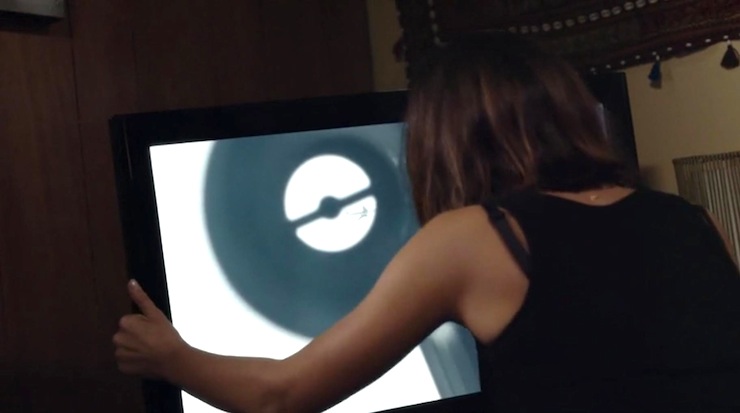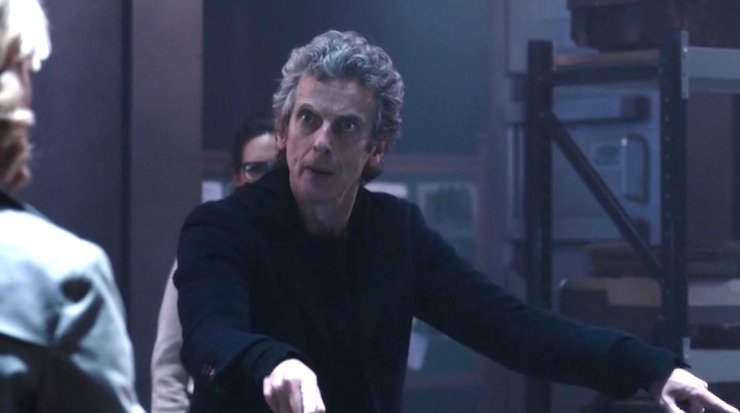It’s up to the Doctor and Osgood to stop a war. And it’s time for Peter Capaldi to blow everyone away with the majestic tears in the eyes.
Hope you had tissues for this one.
Summary
We find human Clara stuck inside her own head (very much alive, of course). She appears to be in her own flat, but keeps seeing and hearing things that pertain to the Doctor’s current situation with Bonnie. She tries to prevent Bonnie from shooting the Doctor out of the air, and succeeds on her first try, but not on her second. Thankfully, when she pauses the playback on the television in her mind, she notices two parachutes exiting the plane as it explodes. Bonnie finds a Zygon who is still in human form, and forces him to change back so she can get the event of film and leak it to the press, hoping to cause panic. She then goes looking for the Osgood box, but finds information on Osgood’s computer that makes is clear that she won’t find it at UNIT HQ.

The Doctor and Osgood are busy trying to escape Zygons when the Doctor gets a text from Clara saying “I’m awake.” Osgood realizes that it’s the real Clara, that she’s alive and using the Zygon version of herself to get information out. They call Bonnie and Clara uses her body to wink whenever the Doctor asks relevant questions, allowing him to discover where her body is. He and Osgood grab a van and start driving to London. Bonnie goes to speak to Clara, pointing out that they can’t lie to each other, having the same pulse. She demands Clara tell the truth or be killed. She asks Clara where the Osgood box is, and Clara tells her it’s in the Black Archive. Bonnie finds out that she only needs Clara’s body imprint to get in, so she can easily get to them. But Clara promises that Bonnie will want to talk to her once she sees the box.
The pod lair is directly below the mall where the Zygon was changed back into his alien form, and the Doctor and Osgood encounter him. The Doctor tries to help, but the Zygon is devastated at what’s been done to him, insisting that he’d wanted only to live on Earth in peace. He kills himself, terrified that his existence will start a war. The Doctor and Osgood run into Kate Stewart, but the Doctor was already told that she’d been killed by Bonnie—making this one a Zygon. They head down to where the pods are, but Clara is missing, so they head to the Black Archive. On their way, Kate Stewart kills her Zygon guards, revealing that she is the real Kate Stewart; she killed the Zygon who came after her in New Mexico. The Doctor is not pleased with her inclination toward violence.

Bonnie has brought Clara’s pod to the Black Archive and pulls her out of it, going in and finding that there are in fact two Osgood boxes, one red and one blue. She presses the buttons on both and finds out that doing so leads to a second lid where each box has two more buttons, one labelled “Truth,” the other “Consequences.” The Doctor, Osgood and Kate arrive, and the Doctor reveals that each button for each box has a different purpose. For the red box, one button will gas and kill the Zygons, the other will blow up the Black Archive. For the blue box, one button will will reveal every Zygon’s true form on Earth, the other will kill them. Bonnie still wants to try her luck, insistent that she goes through with her plan. Kate is willing to respond in turn, and so the Doctor breaks it down for them—these boxes are war, distilled to its purest form. That they haven’t the faintest idea what terror their actions might bring, who will die, who witness unimaginable things. That even once someone wins, there will always be another war, and that every war ends the same way: with people eventually having to stop the fighting and talk to each other. Bonnie begins to waver, and then she realizes that the boxes don’t do anything. They were just a way for the Doctor to talk them out of fighting.
Kate points out a problem—that knowing that boxes are empty could still break down the ceasefire. The Doctor tells her that they’ve had this conversation fifteen times already, and she won’t remember a thing; the Black Archive still has the ability to wipe people’s memories. But in the end, Bonnie realizes that the Doctor hasn’t wiped hers. He claims that he wants her to remember what happened and keep the peace. Bonnie calls off the splinter sect, ending the potential war. Later, the Doctor and Clara are leaving, and the Doctor asks Osgood again—is she human or Zygon? She insists she’s just Osgood… and then another one appears. Bonnie has chosen to live out her life in Osgood’s form, so that there will always be two of them to protect the box and prevent war.

Commentary
So… that was pretty much the definition of tour de force.
We get some great stuff from Clara here, especially in her interactions with Bonnie. (Though I’m confused as to why they’d have the same pulse? Yeah, just hand-wave that one.) All the little, clever things that Clara does to get word out to the Doctor are inspired and fun. I had hoped that we’d see more of how her emotions and memories affected Bonnie and the choices that she made, but on the whole, I enjoyed watching Clara work from inside her own head. (And I also enjoyed watching Jenna Coleman get a chance to play an entirely different character.)

Osgood has morphed entirely from a fun side character who fans could relate to into a character with a purpose that is entirely unique and fascinating within the context of their universe. Her continued insistence that she cannot be defined as either human or Zygon is wonderful, and has the added relevance of applying to so many situations for humans as well—biracial people who are asked to specify one ethnicity over the other, gender fluid people who are constantly asked whether they are men or women. Interestingly, we now have both Osgoods and Ashildr hanging out on Earth, keeping an eye on things… we have to assume that’s going to be important going forward. It’s too bad that Osgood won’t likely be a permanent companion, though, not only because she’s a great character but because it would be great to have another companion who wasn’t completely human again.
Then we find out that Kate Stewart isn’t dead, and the Doctor asks how she survived and she says, “Five rounds rapid,” just like daddy Brigadier Lethbridge-Stewart used to do, and nothing, I’m fine, OKAY I’M CRYING, ARE YOU HAPPY?! You monsters. I mean, I get that the Doctor is upset over the violence involved, but in that particular moment it was really hard for me to care. Have I mentioned that the addition of Kate Stewart might be one of my favorite things about the Moffat era? It just means so much to have that tie to the Brig and old UNIT.

But the centerpiece is inarguably the Twelfth Doctor’s defining moment in the series up to this point, the moment that truly “makes” his Doctor, and perhaps one of the greatest scenes the character has ever been given to play, period. A treatise on war, his philosophy and purpose, every little bit of pain magnified and laid out, all to prevent people from making the same mistakes that they always do. Over a millennia of experiences the Doctor has had, every horror the Time War wrought, all the people he’s lost, and it all comes down to the moment where he can explain, with utterly clarity, that war doesn’t solve any problem. That the only thing that war does is postpone the inevitable—the point where people must sit and talk to each other. And in the interim, so much is destroyed.
Capaldi wrings this scene out like he’s a parched man searching for water, he hits every emotional note, and if you were never sold on this Doctor the way you were for previous incarnations, I dare you to deny him now. The tears, the frustration, that deep sadness that he wears so well, we can see where this Doctor came from, what he has to lose this time around. And for all that pain, he doesn’t resign himself. He still believes that people can be better. He never lets go of that belief. In this age of bitter, betrayed, angry protagonists, it means so much to see a hero who believes that the best is still possible. Who forgives and loves and takes it on himself to prevent other people from hurting. I think what the Doctor told little Danny Pink last season applies more than ever, here: Being scared is a superpower. And it’s his fear, in this moment, that ultimately saves the world.

And then the episode hits you with one extra revelation—this is the fifteenth time he’s had this argument with them. He has already tried fifteen times, and he kept going because there was only one outcome allowed.
Ironically, the episode’s greatest strength also leads to its primary weakness. While the plot becomes all about big ideas, the horror of war at its most basic, we lose the Zygon narrative. The idea of a splinter sect that wants the ability to stop hiding their forms is never addressed again in the story. We don’t know why it’s so easy for Bonnie to call her people off and demand that they live peacefully. It’s an unfortunate gap that would have made an excellent story even stronger.

We end with Clara asking what it was like for the Doctor to think she was dead, and his response is “Longest month of my life.” When Clara insists that she was only “dead” to him for five minutes, he replies, “I’ll be the judge of time.” Since it’s Doctor Who, it’s possible that this reply might get explained away in some complex plotting mechanism, but I dearly hope it doesn’t. Because the Doctor is a Time Lord, and we know he experiences time differently from us. And that line tells us pretty much everything we need to know about what that entails.
Whovian asides and funny highlights:
- The Doctor uses a Union Jack parachute, which is a hilarious James Bond reference—007 uses such a parachute in The Spy Who Loved Me. So really, the Doctor’s comment about “camouflage” works on more than one level.
- “The Day of the Doctor” is referenced in several ways here: the appearance of the Black Archive, the use of the mind-wiping function there, and the Doctor talking about his own “button pressing” moment where he nearly destroyed Gallifrey with The Moment.
- Former companion Harry Sullivan is finally verbally acknowledged as the one who created the Zygon gas, and the Doctor calls him “the imbecile,” which is a specific reference to the Fourth Doctor story “Revenge of the Cybermen.” (Harry caused a rockslide in that serial, among other things.)
Emmet Asher-Perrin just looks at that picture of Capaldi smiling and starts to tear up. You can bug her on Twitter and Tumblr, and read more of her work here and elsewhere.










